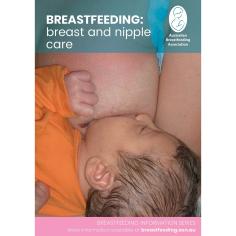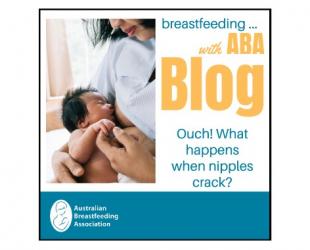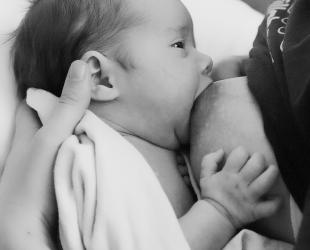Breastfeeding still not comfortable? Help your nipples to heal.
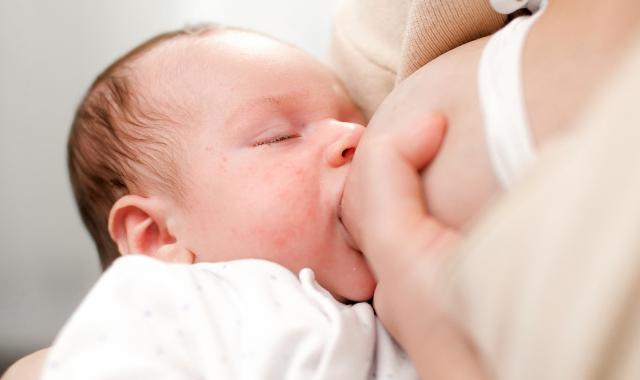
Things should improve when the cause of your sore nipples is found and treated. In the meantime, we can help you to find some relief from the pain.
Knowing the cause of your pain can help choose treatment
Nipples are a sensitive part of the body, so even very slight damage can cause a lot of pain.
- Still early days, but no visible damage? Nipples can take time to get used to the pulling and stretching of breastfeeding. This type of pain is usually felt at the start of each breastfeed but eases as the milk begins to flow. It is common and usually goes away within the first week or so.
- Cracked or grazed nipples in the first few weeks are usually a sign that the baby’s mouth is causing damage as they learn to breastfeed. The good news is that small changes to the way you hold your baby during feeds, or the way they take your breast in their mouth, can help. These two things are known as positioning and attachment.
- When pain begins after weeks, months or years of comfortable breastfeeds, there are a few possible causes. These include changes to your hormones, a distracted baby, and incorrect use of a breast pump. With a little problem solving, you and your baby can get back to the comfortable breastfeeds you know and enjoy.
Unsure what to do next? A chat with a breastfeeding counsellor can help you to find and treat the cause of your sore nipples. Ask for help promptly, so they can begin to heal. When breastfeeding is comfortable, it can be as enjoyable for you as it is for your baby!
Now you’re one step closer to finding the cause of your nipple pain, read on for simple tips you can use right away to ease your discomfort…
Helping your nipples to heal
While you’re getting help with the cause, here are some simple things you can do to help damaged nipples heal:
- Lightly press a warm, wet washcloth onto your nipples for 5 minutes after each feed.
- Keep nipples dry between feeds. If you are using breast pads, hydrogel pads or silver nipple caps, check they are not holding moisture near your skin.
- Gently smear a little breastmilk onto your nipples and let it dry. Breastmilk is healing and helps to prevent infection.
- Before using nipple creams or ointments, speak to your midwife, child health nurse, pharmacist or doctor. A little expressed breastmilk may be all you need.
- Treat your nipples with care as they heal. Use gentle soaps when washing and milk laundry detergent.
- Choose bras or tops made from fabric that doesn’t rub or stick to your nipples.
- If breast pads are sticking, moisten the breast pad by hand expressing some milk into the pad before removing the breast pads
- Seek medical help if you need pain relief, or if healing seems very slow. Once the cause of sore nipples is fixed, they often heal (or at least begin to improve) within days. If not, your doctor can check for infection.
Breastfeeding with sore nipples
We understand that breastfeeding may be the last thing you want to do while your nipples are sore! There are a few reasons why you'll need to keep the milk moving while your nipples are healing:
- Very full breasts can be painful, so keeping them from becoming too full will help with your overall comfort.
- Your baby will still need frequent feeds of breastmilk.
- Removing milk often helps you to build up or keep your milk supply.
If you feel able to, the simplest way to keep the milk moving is to keep feeding your baby at the breast. If the pain is too severe, removing your milk by hand (expressing) for a while is another way for your baby to keep receiving your breastmilk. Only you can know how much pain you are feeling, so be guided by your body when deciding whether to breastfeed or express your milk. Some mums find it more comfortable to do a bit of both while their nipples are healing.

Help your baby to breastfeed
- Offer your baby a feed when they show early signs of hunger (feeding cues). They will be calmer and more likely to breastfeed well.
- Hand express some milk to soften the nipple and the area around it (the areola). This can help your baby to take your nipple deep into their mouth, where it should feel more comfortable.
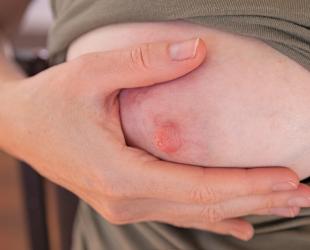
Help the milk to flow
- Make yourself comfortable and relax as much as you can.
- Offer the less sore side first. You can switch to the sore side after the milk begins to flow.
- Gently stroke your breasts or apply warmth just before a feed. This can help to get your milk flowing.
- Use pain relief if needed. Severe pain can make it difficult to relax and the milk may not flow freely.
Read more on helping your milk to flow.

Adjust as needed
- Try different feeding positions and see what works for you. If your baby is still young, hold them skin-to-skin and let them use their instincts to find your breast. This is known as baby-led attachment.
- If it doesn't feel quite right, pull your baby's lower half in closer to your body to help them attach more deeply. Make sure their body is straight and well supported.
- If it’s not working, gently slide a clean finger into the corner of your baby’s mouth to remove them from the breast. Take baby off and try again.
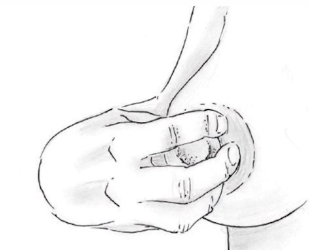
Manage any engorgement
- If your breasts are very full and swollen, your baby might have trouble attaching and your milk may not flow well. This is known as engorgement.
- You can use your fingertips to soften engorged breasts before offering your baby a feed. This method is called reverse pressure softening.
Commonly asked questions about sore nipples
This will depend on the cause of the problem, and how quickly you can get help to fix it.
Once any problem is fixed, feeds should quickly become more comfortable. But if your nipples are damaged, you may still feel some pain while they heal. This is common at the start of the feed, as baby draws your nipple into their mouth. Once the nipple is deep in their mouth, and the milk begins to flow (after about 20-30 seconds), the pain should ease.
Your nipples will only begin to heal once the cause is fixed. It can take a while for them to heal fully, but if you don’t see any improvement after a few days, see your doctor to rule out infection.
Sometimes a damaged nipple gets a crack. You might see this on the nipple itself or where the nipple joins the areola (the darker skin around the nipple). Sometimes the crack is very small and hard to see. Breastfeeding with a crack can be very painful and the cracked nipple may bleed during breastfeeds.
It's safe to continue breastfeeding your baby with cracked or bleeding nipples. You may see traces of blood in their poos or any milk they bring up, but it's not harmful to them. If the pain is too severe, read on for other options.
Someone may have suggested that you try a nipple shield. Shields can be helpful in some cases, but it’s still important that your baby attaches well to your breast. This will mean you are comfortable and your baby can get enough milk.
Before using a shield, seek help (face-to-face if possible) from an ABA breastfeeding counsellor, a lactation consultant or a doctor who has extra training in breastfeeding.
If the pain is very bad, you might like to rest your nipple for 12 to 24 hours to allow healing to begin. It's important to keep the milk moving if you take a break from breastfeeding. This helps to protect your supply and stops your breasts from becoming painfully full. Damaged nipples and overfull breasts can both lead to mastitis.
During this time, express (using your hands or a breast pump) as often as your baby would normally breastfeed. You can feed the expressed breastmilk to your baby using a cup. Cup feeding (rather than bottle feeding) won’t confuse your baby while they are still learning to attach and suck at the breast well.
If you use a breast pump, take care to make sure that the fit is right and the suction is not too strong, or it may still hurt your nipples. You may find hand expressing a gentler option that can still work very well.
Not necessarily. Silver can protect against infection and encourage the growth of new skin cells (much like breastmilk!). Because of this, silver has been used to aid wound healing for many years. But that doesn't necessarily mean silver nipple caps can help to heal your sore or cracked nipples. Overall, the reviews we've heard from mums are mixed.
Here are some good and bad points for you to think about:
- The cool metal may feel soothing on warm, inflamed nipples.
- They can be very pricey and won't fix any underlying problems.
- They are reusable and may stop clothing rubbing against damaged nipples.
- If they do shorten healing time for cracked nipples, it may only be by a matter of days.
- There is no reason to believe they can prevent nipple damage. They shouldn't be used on healthy nipples.
The tried-and-tested tips on this page can bring you relief while you get some help to find and fix the cause of your sore nipples. A call to the National Breastfeeding Helpline on 1800 686 268 is always a great place to start.
Berens, P., Eglash, A., Malloy, M., & Steube, A. M. (2016). ABM clinical protocol #26: Persistent pain with breastfeeding. Breastfeeding Medicine, 11(2), 46–53.
Brodribb, W. (ed). (2019). Nipple pain. In Breastfeeding Management in Australia (5th ed., pp. 137-147). Australian Breastfeeding Association.
Cotterman, K. J. (2004). Reverse pressure softening: A simple tool to prepare the areola for easier latching during engorgement. Journal of Human Lactation, 20(2), 227–237.
Dennis, C. L., Jackson, K., & Watson, J. (2014). Interventions for treating painful nipples among breastfeeding women. Cochrane Database of Systematic Reviews. https://doi.org/10.1002/14651858. CD007366.pub2
Joanna Briggs Institute. (2009). The management of nipple pain and/or trauma associated with breastfeeding. Australian Nursing Journal, 17(2), 32–35.
Walker, M. (2013). Are there any cures for sore nipples? Clinical Lactation, 4(3).
Wang, Z., Liu, Q., Min, L., & Mao, X. (2021). The effectiveness of the laid-back position on lactation-related nipple problems and comfort: A meta-analysis. BMC Pregnancy and Childbirth, 21(1), 248.
© Australian Breastfeeding Association June 2024
Find out more about managing sore nipples
Online interactive session free for members
Newborn Virtual Village - Comfortable attachment & early days support

Evidence-led info and practical tips from our Breastfeeding Information Series
Breastfeeding: breast and nipple care
